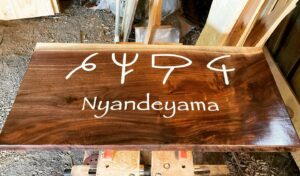The Mende syllabary, also called “Kikakui” after its first three characters, was conceived around 1917 by Mohamed Turay, an Islamic scholar in the Sierra Leonean town of Maka. He taught his version, which had 42 characters, to his son-in-law and student, Kisimi Kamara, a tailor from the town of Vaama. Kamara went on to add another 150 syllabic characters, and he also began to promote the script outside of the Barri chiefdom, in southern and eastern Sierra Leone, beginning in the 1920s.
Their inspiration was almost certainly the Vai syllabary from neighboring Liberia, by then some 90 years old and in considerable regional use to write related Mande languages. To this general syllabic structure and aesthetic, Turay and Kamara added characters inspired by Arabic, an indigenous corpus of Mende graphic symbols, and other characters from their own imaginations.
The script, which is written from right to left, was used for correspondence, record-keeping, producing court documents, and in writing Christian and Islamic texts. In the 1940s, however, the British established the Protectorate Literacy Bureau in Bo, which introduced a Latin-based system for Mende was taught. Not surprisingly, use of the Mende syllabary began to decline, and by the end of the twentieth century various authorities estimated its number of users as anywhere between a few hundred and zero.
Rumors of its death were exaggerated, however. Konrad Tuchscherer, perhaps the leading active expert on West African scripts, worked with Michael Everson to develop a Unicode proposal for Mende Kikakui, and a font and an input tool were developed by Jason Glavy and Andrew Cunningham, respectively.
As of early 2023, the Kikakui syllabary shows small but distinct signs of life. Konrad Tuchscherer is in Sierra Leone teaching a class in the syllabary and reports intense interest among his students, many of whom have begun writing stories and poetry in Kikakui, and collecting Mende proverbs to write in Kikakui. Meanwhile, Mohamed Pujeh plans to write a Mende Kikakui dictionary and is working with Craig Cornelius of Google to create a keyboard-ready digital version of the script.
And the Endangered Alphabets Project has contributed three hand-carved signs to be erected at the entrances to the three villages where the script was kept alive–in exile, so to speak–during its missing years.

SS: https://scriptsource.org/cms/scripts/page.php?item_id=script_detail&key=Mend
Font: https://www.fontspace.com/unicode/script/mende-kikakui
Mende source material: https://tenthousandrooms.yale.edu/node/114383/mirador?canvas=181451
Wiki: https://en.wikipedia.org/wiki/Mende_Kikakui_script
Omni: https://www.omniglot.com/writing/mende.htm
Unicode: https://www.unicode.org/L2/L2012/12023-n4167-mende.pdf
History article on JSTOR: https://www.jstor.org/stable/1771691?seq=1/subjects